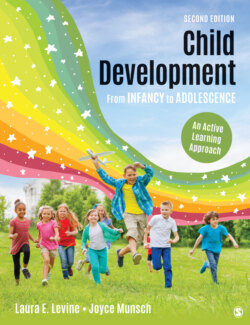Читать книгу Child Development From Infancy to Adolescence - Laura E. Levine - Страница 153
На сайте Литреса книга снята с продажи.
Natural or “Quasi” Experiments
ОглавлениеSometimes a researcher can test a hypothesis using a natural or “quasi” experiment that takes advantage of a situation that occurs naturally. In West Africa, administrators in private schools can decide which discipline techniques they will use in their schools. Some choose to use corporal punishment, such as slapping or pinching children when they misbehave, while other administrators choose to use nonphysical child management techniques (Talwar & Lee, 2011). Researchers were able to use this naturally occurring situation to examine the effect of these two different school environments on children’s willingness to lie about their misbehavior.
Natural or “quasi” experiment: Research in which the members of the groups are selected because they represent different naturally occurring “treatment” conditions.
Children from both types of schools listened to a researcher play with a toy while they had their back turned to her. She then said she needed to leave the room for a while and told the child not to turn around to look at the toy while she was gone. When she returned, she asked the child if he or she had looked at the toy in her absence. Although the majority of the children from both types of schools peeked, many more of the children from the schools that used physical punishment denied what they had done. In other words, they lied about the fact that they had peeked. The researchers concluded that the punitive school environment gave children the motivation to lie as a way to protect themselves from punishment.
Similar to experiments conducted in a laboratory, researchers in this study controlled as many variables as possible with the exception of the variable they were interested in studying. Both schools were located in the same city and enrolled students from similar socioeconomic backgrounds. Students from the two schools also scored at a similar level on some standardized tests of cognitive ability. The relevant variable that differed between them was the discipline practices of the school they attended, so this was the independent variable in this study. The likelihood that they would lie about their misbehavior was the dependent variable measured at the end of the experiment.
One drawback in a natural experiment is that it is more difficult to rule out other factors that may affect the results. In a true experiment, some teachers would be randomly assigned to use physical punishment and a comparable group of teachers would be assigned to use nonphysical punishment. Clearly this research could only be done as a natural experiment because no teacher would agree to hit a child when that teacher did not believe in using physical punishment in a classroom. However, because this was a natural experiment, it is possible that teachers who were drawn to the school that used physical punishment differed from those who went to the other school in other ways that may have affected the students’ behavior. It is possible that it is the teacher’s personality or some other difference in the school environment that is responsible for the outcome rather than the use of physical punishment.
